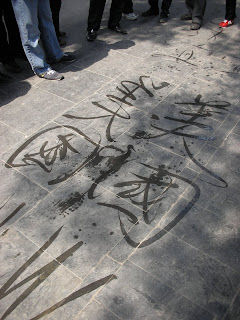Here are some shots from the Summer Palace.
 A bronze statue of a Chinese lion.
A bronze statue of a Chinese lion.Dancers in traditional Chinese dress. This had to be our substitute for the opera. It made me glad we ran out of time Friday night. A short performance was sufficient.

A young woman in traditional Chinese dress. She was a decorative guide inside the building behind. I wasn't allowed to take a picture inside the building, but with the help of our hosts, I was able to persuade her to stand in the doorway for this shot (there's also one of me standing beside her, but you won't see many shots of me on this blog).

Chinese emperors apparently have this thing about strange looking rocks. One emperor found this rock some distance from Beijing and was bringing it back for display. However, along the way he ran out of money to pay the people who were transporting it for him, so it was left by the side of the road. Decades later a different emperor saw the rock as he was passing by and arranged for the rock's journey to Beijing to be completed.

This picture shows some of the detail and craftsmanship of the buildings at the Summer Palace. It was by far the most well maintained of all the sites. They may have just finished their refurbishment, because there was almost no work going on here, in contrast to the Forbidden City and the Temple of Heaven.

This photo is of the main tower of the summer palace.

Some more details from the decorations at the Summer Palace.

A corridor from the Summer Palace. The painting is beautiful, but also served to preserve the wood. Very few of the historical buildings around Beijing are made from brick or stone.

Details and a painting of a Chinese general on horseback.

 This a painting of a very wise Chinese philosopher/general. One of our hosts delighted in telling the story of one of his victories. During a battle with a Chinese warlord, this philosopher made a strategic retreat to a nearby city. His army continued to retreat, but he stayed on the wall of the city overlooking the main gate, which he instructed his staff to leave open. He then proceeded to play a solitaire game on top of the wall in plain view of the advancing troops. The warlord saw the philosopher and the open gate and because he couldn't believe that the philosopher was surrendering, thought it must be a trap. Fearing the wisdom and cleverness of the philosopher, he withdrew his troops.
This a painting of a very wise Chinese philosopher/general. One of our hosts delighted in telling the story of one of his victories. During a battle with a Chinese warlord, this philosopher made a strategic retreat to a nearby city. His army continued to retreat, but he stayed on the wall of the city overlooking the main gate, which he instructed his staff to leave open. He then proceeded to play a solitaire game on top of the wall in plain view of the advancing troops. The warlord saw the philosopher and the open gate and because he couldn't believe that the philosopher was surrendering, thought it must be a trap. Fearing the wisdom and cleverness of the philosopher, he withdrew his troops. This is the last shot for this post. As we were moving toward the gate, we saw a large crowd gathered on the sidewalk, so we stopped to see what was going on. The draw (literally, as you'll see) was an elderly Chinese gentleman drawing Chinese characters on the sidewalk with water. The walk was dry and rather dusty and he was using two pieces of PVC pipe with regular water bottles at each end. On one end the bottles were attached to a brush, which looked exactly like a giant calligraphy brush. What made this interesting was that he was writing with both hands at the same time. When we stopped to watch, he asked us if we were Americans. He said he was a professor of literature at Beijing University who came out on the weekends to do his drawings to balance his right brain and his left brain. He drew another series (in English) that said "Welcome"--again with both hands at the same time.
This is the last shot for this post. As we were moving toward the gate, we saw a large crowd gathered on the sidewalk, so we stopped to see what was going on. The draw (literally, as you'll see) was an elderly Chinese gentleman drawing Chinese characters on the sidewalk with water. The walk was dry and rather dusty and he was using two pieces of PVC pipe with regular water bottles at each end. On one end the bottles were attached to a brush, which looked exactly like a giant calligraphy brush. What made this interesting was that he was writing with both hands at the same time. When we stopped to watch, he asked us if we were Americans. He said he was a professor of literature at Beijing University who came out on the weekends to do his drawings to balance his right brain and his left brain. He drew another series (in English) that said "Welcome"--again with both hands at the same time.This was typical of the reception we got wherever we went. We were either treated as unexceptional or made to feel very welcome. I never experienced any negative vibes during the whole trip. It's probably the last trip I'll make overseas for the Fed and I think it was the best of all.
No comments:
Post a Comment